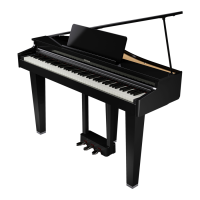Basic Operations of the GP-3
7
Before You Play
The power to this unit will be turned o automatically
after a predetermined amount of time has passed
since it was last used for playing music, or its buttons
or controls were operated (Auto O function). If you
do not want the power to be turned o automatically,
disengage the Auto O function (p. 3).
¹ When the power is turned o, any settings you were editing
will be lost. You must save settings that you want to keep
(p. 11).
¹ To restore power, turn the power on again.
Turning the power on/o
Press the [Ā] (power) button to turn on the power.
Long-press the [Ā] (power) button to turn the power o.
* You might hear some sound when switching the unit on/o.
However, this is normal and does not indicate a malfunction.
Adjusting the Volume
Use the two volume buttons to adjust the volume.
[
] (volume +) button: raises the volume.
[
] (volume -) button: lowers the volume.
These buttons adjust the built-in speaker volume when
you are using the speakers, and the buttons adjust the
headphones volume when headphones are connected.
* The indicators to the right of the buttons light up according to the
volume (more lights = louder volume). When all of the indicators
are lit, the volume is at maximum. When all of the indicators are o,
no sound is heard.
Changing the Settings
Hold down the [ ] (settings) button and press the keys
to switch between the various functions.
Ø “Quick Operations” (p. 2)
Using the Pedals
By pressing the pedals, you can apply eects to the sound of the piano.
The pedals on Roland pianos work the same as typical grand piano pedals.
Lower the adjuster located under the pedals so that it comes
into contact with the oor. If you’ve placed the piano on a
carpet or similar surface, lower the adjuster so that it presses
somewhat strongly against the oor.
Adjuster
Soft pedal
Sostenuto pedal
Damper pedal
Damper pedal
(right)
While this pedal is held down, the notes sustain without a break in the sound, even if you take your ngers o the keys. The resonance of the sound is aected
by how deeply you press the pedal.
* The higher notes of the piano (from the highest key down around 1½ octaves) linger for a while after you play them even if the pedal is not
pressed, like a grand piano.
Sostenuto pedal
(center)
When you play a note and then press this pedal before releasing the keys, the sound sustains for only those keys.
* This has no eect on notes that you play after pressing the pedal.
Soft pedal
(left)
This pedal is used to make the sound softer. Playing with the soft pedal depressed produces a sound that is not as strong as when otherwise played with the
equivalent strength. The softness of the tone can be varied subtly by the depth to which you press the pedal.
* As this is a rather subtle eect, it may be dicult to notice when playing certain tones or in certain performance situations.
* When operating the pedal, take care not to pinch your ngers between the moving part and the piano unit. In places where small children are present, make sure that
an adult provides supervision and guidance.

